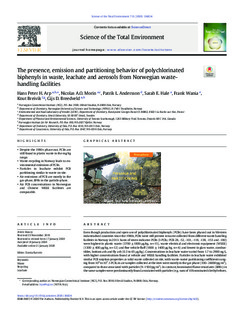| dc.description.abstract | Even though production and open use of polychlorinated biphenyls (PCBs) have been phased out in Western industrialised countries since the 1980s, PCBs were still present in waste collected from different waste handling facilities in Norway in 2013. Sums of seven indicator-PCBs (I-PCB7: PCB-28, -52, -101, -118, -138, -153 and -180) were highest in plastic waste (3700 ±1800 μg/kg, n=15), waste electrical and electronic equipment (WEEE) (1300 ± 400 μg/kg, n=12) and fine vehicle fluff (1800 ± 1400 μg/kg, n=4) and lowest in glass waste, combustibles, bottom ash and fly ash (0.3 to 65 μg/kg). Concentrations in leachate water varied from 1.7 to 2900 ng/L, with higher concentrations found at vehicle and WEEE handling facilities. Particles in leachate water exhibited similar PCB sorption properties as solid waste collected on site, with waste-water partitioning coefficients ranging from 105 to 107. I-PCB7 in air samples collected at the sites were mostly in the gas phase (100–24000 pg/m3), compared to those associated with particles (9–1900 pg/m3). In contrast brominated flame retardants (BFRs) in the same samples were predominantly found associated with particles (e.g. sum of 10 brominated diethyl ethers, ΣBDE10, associated with particles 77–194,000 pg/m3) compared to the gas phase (ΣBDE10 6–473 pg/m3). Measured gas-phase I-PCB7 concentrations are less than predicted, assuming waste-air partitioning in equilibrium with predominant waste on site. However, the gas-particle partitioning behavior of PCBs and BFRs could be predicted using an established partitioning model for ambient aerosols. PCB emissions from Norwegian waste handling facilities occurred primarily in the form of atmospheric vapor or leachate particles. | |
